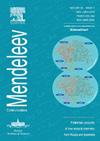二甲腈与乙炔在KOBut/DMSO/THF体系中的反应:2-芳基-3-乙基-4-芳基-5-甲基吡咯和氨基丙烯醛的自组织
IF 1.7
4区 化学
Q3 CHEMISTRY, MULTIDISCIPLINARY
引用次数: 0
摘要
在KOBut/DMSO/THF体系中,苯并腈与乙炔气体(12-14 °C, 15 min)反应生成2-芳基-3-乙基-4-芳基-5-甲基吡咯和芳基氨基丙烯醛,它们分别由2分子苯并腈与3分子乙炔和1分子苯并腈与1分子乙炔自组织(在微量水存在的情况下)产生。本文章由计算机程序翻译,如有差异,请以英文原文为准。

Reaction of benzonitriles with acetylene in the KOBut/DMSO/THF system: self-organization of 2-aryl-3-ethynyl-4-aroyl-5-methylpyrroles and aminoacroleins
Benzonitriles react with acetylene gas (12–14 °C, 15 min) in the KOBut/DMSO/THF system to afford 2-aryl-3-ethynyl-4-aroyl-5-methylpyrroles and arylaminoacroleins that result from self-organization (in the presence of trace water) of two molecules of benzonitrile with three molecules of acetylene and one molecule of benzonitrile with one molecule of acetylene, respectively.
求助全文
通过发布文献求助,成功后即可免费获取论文全文。
去求助
来源期刊

Mendeleev Communications
化学-化学综合
CiteScore
3.00
自引率
21.10%
发文量
226
审稿时长
4-8 weeks
期刊介绍:
Mendeleev Communications is the journal of the Russian Academy of Sciences, launched jointly by the Academy of Sciences of the USSR and the Royal Society of Chemistry (United Kingdom) in 1991. Starting from 1st January 2007, Elsevier is the new publishing partner of Mendeleev Communications.
Mendeleev Communications publishes short communications in chemistry. The journal primarily features papers from the Russian Federation and the other states of the former USSR. However, it also includes papers by authors from other parts of the world. Mendeleev Communications is not a translated journal, but instead is published directly in English. The International Editorial Board is composed of eminent scientists who provide advice on refereeing policy.
 求助内容:
求助内容: 应助结果提醒方式:
应助结果提醒方式:


